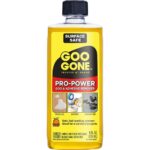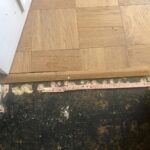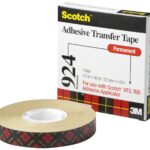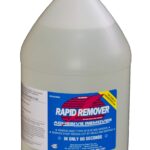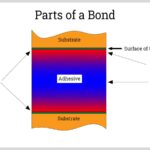PSA adhesive, or Pressure Sensitive Adhesive, is a type of adhesive used in many different applications. This adhesive is typically applied to a surface, and then held in place with pressure while it dries. It is commonly used in the manufacturing of products such as labels, tapes, foam, and plastics. PSA adhesive provides a strong bond that is permanent and resists vibration, temperature fluctuations, and can withstand a certain amount of humidity. It is also resistant to many solvents, such as oils and gasoline.
This makes it an ideal adhesive for many products that need to hold up in a variety of environments. PSA adhesive bonds quickly and is easy to use, making it a popular choice for a wide range of projects. It can be applied with a brush, roller, or sprayer. It is also available in a variety of colors, so it can be used to match the rest of the project’s materials. In addition to its use in manufacturing, PSA adhesive is also used for home and office projects. It is commonly used to hang pictures, attach signs, mount mirrors, and even repair broken items. PSA adhesive is an incredibly versatile adhesive, used for a variety of applications in both the industrial and home setting. It is easy to use, provides a strong bond, and is resistant to many environmental conditions.
What is an example of a pressure sensitive adhesive?
A pressure sensitive adhesive (PSA) is an adhesive that is applied in a thin layer and can be activated by mild pressure. It has a wide range of applications, from consumer to industrial uses. An example of a pressure sensitive adhesive would be a sticker label. The adhesive backing on the label is activated by slight pressure and allows it to adhere to the surface. This type of adhesive is often used in labeling products and in many crafting applications.
Another common use for PSA adhesives are tapes. This type of adhesive is used to bond two surfaces together and is often used in packaging and sealing applications. The adhesive forms a bond between the surfaces and becomes stronger when under pressure. Pressure sensitive adhesives are also used in medical applications. Bandages and medical tapes use PSA technology to provide an adhesive that will hold the bandage or tape in place. Pressure sensitive adhesives offer many advantages over other types of adhesive. They are easy to apply and don’t require a lot of pressure to activate the adhesive. Many PSA adhesives also have good temperature and moisture resistance.
What is the use of pressure sensitive adhesive?
Pressure sensitive adhesive (PSA) is an adhesive that is designed to create a strong bond when pressure is applied. This type of adhesive is commonly used in many industries, such as electronics, automotive, and medical. PSA adhesives are popular because they provide a fast and reliable bond. They can also be used on a variety of different substrates, including metal, plastic, paper, and more. Additionally, they can provide a permanent bond or a temporary bond depending on the application.
PSA adhesives are often used in applications such as packaging, labelling, and attaching components in the automotive and electronics industries. They can also be used in medical devices, such as catheters and other medical equipment. One of the main advantages of using a PSA adhesive is that it provides a strong bond without the need for curing. This makes it a great choice for applications that need to be done quickly and efficiently. Additionally, PSA adhesives often have a long shelf life, so they can be stored and used over a longer period of time. Overall, PSA adhesives are a reliable and versatile tool used in a wide variety of applications. They provide a strong bond quickly and without the need for curing, making them a great choice for many industries.
Is pressure-sensitive adhesive removable?
What is PSA Adhesive? Pressure-sensitive adhesive (PSA) is an adhesive material that sticks to the surface when light pressure is applied to it. It is often used in industrial and consumer applications where the adhesive needs to be easily removable. PSA adhesives are used for attaching labels, stickers, and other materials. They are also used for providing insulation and sealing, and also for bonding materials together. PSA adhesives are usually made from polymers and resins and come in various forms such as tapes, liquid glues, and films.
So, is pressure-sensitive adhesive removable? Generally, yes. Most PSA adhesives can be removed using solvents and mechanical methods such as scraping or peeling. The removal process varies depending on the type of adhesive and the surface it is adhered to. In addition, there are some PSA adhesives that are specifically designed to be easily removable. These adhesives often have a low tack, meaning they won’t leave a residue behind when they are removed. Overall, pressure-sensitive adhesive is generally a removable material. In certain cases, it may require solvents or mechanical methods, but there are also PSA adhesives that are specifically designed to be easily removable. This makes it a great choice for many applications where removal is desired.
How long does pressure-sensitive adhesive last?
What is PSA Adhesive? Pressure-sensitive adhesive (PSA) is a type of adhesive that forms a bond when pressure is applied. It is typically used to affix items to surfaces, such as labels, stickers and tapes. How Long Does Pressure-Sensitive Adhesive Last? The longevity of PSA adhesive depends on several factors, such as the type of material it is applied to, the environmental conditions, and the amount of wear and tear it is subjected to. Generally, PSA adhesive can last from a few months to a few years or even longer. What Affects the Longevity of PSA Adhesive? The wear and tear of PSA adhesive is affected by temperature, humidity, and the types of surfaces they are applied to.
For instance, PSA adhesive applied to a smooth, non-porous surface will last longer than when applied to a rough, porous surface. Moreover, extreme temperatures can cause PSA adhesive to weaken and become brittle, reducing its ability to stick. What Can Extend the Life of PSA Adhesive? The life of PSA adhesive can be extended by applying it in the right environment, such as a clean and dry surface and away from extreme temperatures. Additionally, maintaining the adhesive bond, such as occasionally reapplying pressure and cleaning off any dust or dirt can also help to keep it from losing its grip. Conclusion In conclusion, the longevity of PSA adhesive can range from a few months to a few years or longer depending on the environment, surface and other factors. Taking the necessary steps to protect the adhesive from wear and tear can lengthen its lifespan.
What is meant by pressure sensitive?
Pressure sensitive adhesives (PSA) are a type of adhesive that require a certain amount of pressure to adhere to a material or surface. This pressure can be applied by either hand or a tool such as a roller. PSAs can be applied in a variety of ways, including spraying or printing, depending on the type of material being used. PSAs are popular for a wide range of applications due to their ability to bond firmly and securely under pressure, without the need for heat or solvents. PSAs are available in a variety of forms, including acrylic, rubber, and silicone-based adhesives, with differing properties to suit different applications.
Each type of adhesive has its own advantages and disadvantages, making it important to select the right type for the job. Acrylic PSAs are strong, reliable, and durable, making them suitable for outdoor and industrial applications. Rubber-based PSAs are more flexible and offer a greater range of movement, which makes them ideal for applications where the material is likely to be subject to movement or vibration. Silicone PSAs are highly heat-resistant and provide good adhesion and release properties. PSAs are also available in a range of different tack levels, meaning how quickly and securely they stick to the surface. High-tack PSAs provide a stronger grip, while low-tack PSAs are less likely to leave behind residue when they are removed. Overall, PSAs are an excellent choice for a wide range of applications, offering reliable adhesion and secure bonding with just the right amount of pressure. By selecting the right type and tack level for the job, you can be sure that the adhesive will do its job effectively and efficiently.
How long does pressure sensitive adhesive last?
What is PSA Adhesive? Pressure Sensitive Adhesive (PSA) is a type of adhesive that is applied to a surface with pressure, and is held in place without the need for heat or a solvent. PSA adhesives are typically used in bonding applications, such as attaching labels and signs to a variety of substrates. How Long Does PSA Adhesive Last? The longevity of a PSA adhesive depends on the environment it is exposed to and the substrate it is applied to. Generally, PSAs perform best when applied to clean, dry surfaces and in a relatively low-temperature environment. Under normal conditions, PSA adhesives can last anywhere from several hours to several years, depending on the type of adhesive used.
What Factors Affect the Longevity of PSA Adhesive? The environment in which a PSA adhesive is used will have a significant effect on its lifespan. In particular, extremes of temperature and humidity can reduce the lifespan of a PSA adhesive. Additionally, the substrate to which the adhesive is applied can also affect its longevity; for example, some PSAs will not adhere effectively to oily or greasy surfaces. What Type of PSA Adhesive Should Be Used? The type of PSA adhesive that should be used will depend on the application and environment. Generally speaking, acrylic adhesives are preferred for most applications, as they have a good balance of adhesion, shear strength and temperature resistance. For high-temperature applications, silicone-based PSAs may be a better option. How Can the Longevity of PSA Adhesive Be Maximized? The longevity of PSA adhesive can be maximized by using the correct type of adhesive for the application, and applying it to a clean, dry surface. Additionally, it is important to ensure that the adhesive and substrate are protected from extreme temperatures and humidity, as these can significantly reduce the lifespan of the adhesive.
How do you remove pressure sensitive adhesive?
What is PSA Adhesive? PSA Adhesive stands for Pressure Sensitive Adhesive and is an adhesive that forms a bond when pressure is applied. It is a type of adhesive that is used to create a strong, permanent bond between two surfaces. Removing PSA Adhesive can be a difficult task, as it is designed to be strong and durable. One of the best ways to remove PSA Adhesive is to use a solvent that is designed to break down the bond between the adhesive and the surface it is bonded to. This can be done by either spraying the solvent onto the adhesive or soaking it in the solvent.
Another way to remove PSA Adhesive is to use a specially designed adhesive removal product. These products are specifically designed to break down the bond between the adhesive and the surface it is attached to. They are typically made up of a combination of solvents and other ingredients that help to break down the adhesive. In addition to solvents and adhesive removal products, you can also use heat or mechanical force to remove PSA Adhesive. Heat can be used to soften the adhesive and make it easier to remove. You can also use mechanical force, such as scraping or sanding, to break the bond between the adhesive and the surface. Ultimately, the best way to remove PSA Adhesive depends on the situation. Solvents, adhesive removal products, heat, and mechanical force are all viable options for removing PSA Adhesive. Before attempting any of these methods, always test a small area to ensure that the surface is not damaged.
Is silicone a pressure sensitive adhesive?
A pressure sensitive adhesive (PSA) is a type of adhesive that requires very little pressure to form a bond. This type of adhesive is usually a type of rubber, plastic, or silicone. Silicone is a popular choice for a pressure sensitive adhesive because it is resistant to extreme temperatures, has low toxicity, and is easy to apply. It is also a good choice because it can bond to a variety of surfaces, making it flexible and versatile. Silicone is also great for use on products that require some flexibility, such as electronic devices or medical devices.
It is also an excellent choice for applications where the adhesive must remain flexible and strong over time. When applying silicone as a pressure sensitive adhesive, it is important to ensure that the surfaces to be bonded are clean and free of dirt, grease, and other contaminants. This will ensure that the bond is as strong as possible. Overall, silicone is an excellent choice for a pressure sensitive adhesive. It is versatile, strong, and durable, making it suitable for a wide range of applications. It is also relatively easy to apply and can bond to a variety of surfaces.
Is pressure sensitive adhesive permanent?
What is PSA adhesive? PSA adhesive, or Pressure Sensitive Adhesive, is an adhesive made of a combination of polymers, resins, and other additives. It is commonly used in tape, labels, and medical applications. PSA adhesive is usually characterized by its ability to bond with surfaces quickly and be easily removable. It is also pressure sensitive, meaning that it can be activated with light pressure and does not need to be heated or cooled for the adhesive to be effective. The question then arises, is pressure sensitive adhesive permanent? The answer to this question depends on the type of PSA adhesive used and the surface it is being applied to.
Generally, PSA adhesives are considered to be semi-permanent and can be removed with some effort. However, when applied to certain surfaces such as glass or metal, the adhesive may become more permanent and difficult to remove. In conclusion, the answer to the question “Is pressure sensitive adhesive permanent?” is that it depends. PSA adhesives are usually semi-permanent and can be removed with some effort, however when applied to certain surfaces, they may become more permanent. It is important to research the type of adhesive and surface it is being applied to before use in order to determine the best result.
What surfaces does silicone not stick to?
What is PSA Adhesive? PSA Adhesive stands for Pressure Sensitive Adhesive and is a type of adhesive commonly used in manufacturing and construction. It is usually a rubber-based adhesive that is used to attach materials together, such as fabrics, plastics, and metals. What surfaces does silicone not stick to? Silicone is a type of material that does not stick to some surfaces, including polyethylene and polypropylene plastics, powder-coated metals, and any surface that has been treated with a silicone release agent. It also does not bond well with some paints, such as those containing teflon, and can’t adhere to greasy surfaces. In summary, silicone does not stick to polyethylene or polypropylene plastics, powder-coated metals, any surface treated with a silicone release agent, paints containing teflon, and greasy surfaces. It is important to note that PSA Adhesive is not a suitable replacement for silicone when bonding these materials.
What adhesive should I use?
When looking for adhesives to use, PSA (Pressure Sensitive Adhesive) is an ideal choice. It’s a type of adhesive that is activated by pressure and is often used for non-permanent bonding. PSA is most commonly used for mounting items and objects, such as photos, artwork, and advertisements, to a variety of materials. Advantages of using PSA include its easy application, surface versatility, and instant bond. It forms a strong bond at room temperature and can be used on a wide variety of surfaces, including paper, plastic, metal, and wood.
It is also easy to use and can be applied with many tools, such as a brush, knife, or a roller. When selecting a PSA adhesive, it is important to consider the application and the type of material being used. Generally, PSA adhesives are classified according to their strength: permanent, removable, and repositionable. Permanent PSA is a strong adhesive used for long-term applications, whereas removable and repositionable PSA are more temporary and can be removed and reapplied without leaving behind residue. Ultimately, the type of PSA adhesive best for the job depends on the specific material and application. Choosing the right PSA adhesive can ensure a successful outcome, so it’s important to select the adhesive that is best suited for the job.
What is the acceptable moisture level for your adhesive?
PSA adhesives, or pressure sensitive adhesives, are a type of glue used for many applications. They are designed to stick to surfaces quickly and easily, but the effectiveness of the adhesive depends on the moisture level of the surfaces and the environment. For optimal performance, the acceptable moisture level for PSA adhesives is generally considered to be between 5 and 20%. If the moisture level of the surface is higher than 20%, the adhesive may take longer to set or may not set properly at all. On the other hand, if the adhesive is exposed to moisture levels lower than 5%, it may not provide enough of a bond and the adhesion may be weaker than desired.
It is important to keep in mind that the moisture level of the surface being adhered is only part of the equation. Temperature and humidity of the surrounding environment also play an important role in the performance of the adhesive. In general, the ideal temperature for PSA adhesive applications is between 18 and 30°C, and the ideal relative humidity is between 40 and 80%. In order to get the best performance from your PSA adhesive, it is necessary to monitor the moisture level, temperature, and humidity of both the surface and the surrounding environment. For optimal results, the moisture level, temperature, and humidity should all fall within the acceptable range for PSA adhesives. By following these guidelines and monitoring the moisture level of the surface and environment, you can ensure that your PSA adhesive will provide the best possible performance.
Should I use subfloor adhesive?
PSA (pressure sensitive adhesive) adhesive is a type of adhesive used to create a bond between two surfaces. It is often used in the construction and flooring industry, and can be found in products like subfloor adhesive. Subfloor adhesive is a great choice for a variety of flooring projects. It is especially effective for installing hardwood, laminate, and tile flooring. The adhesive creates a strong bond, ensuring the flooring is secured to the subfloor.
When deciding whether to use subfloor adhesive, there are several factors to consider. The type of subflooring and flooring materials should be taken into account. Additionally, the environment of the room should be considered, as some adhesives may not be suitable for damp or cold conditions. Overall, using subfloor adhesive is a great way to ensure your flooring is properly installed. It is a strong and reliable adhesive, and is often the best option when installing flooring. Before using subfloor adhesive, it is important to make sure it is the right product for your project.
What is the best adhesive for a windshield?
Psa adhesive is the best adhesive for a windshield because it provides a reliable bond and helps the windshield stay in place. The adhesive is designed to easily adhere to the windshield and other surfaces, making it a great option for any type of windshield installation. In addition to being strong and reliable, Psa adhesive dries quickly and can be used in any type of weather. The adhesive also has a long shelf life, making it a great choice for any automotive parts store. When applying the adhesive, it is important to apply it evenly and to make sure it is evenly spread across the windshield.
This will ensure that it forms a strong bond and that the windshield stays in place. Overall, Psa adhesive is the best adhesive for a windshield because it is reliable, strong, and easy to apply. It dries quickly and can be used in any type of weather. Additionally, it has a long shelf life, making it a great choice for any automotive parts store.
What is pressure sensitive adhesive
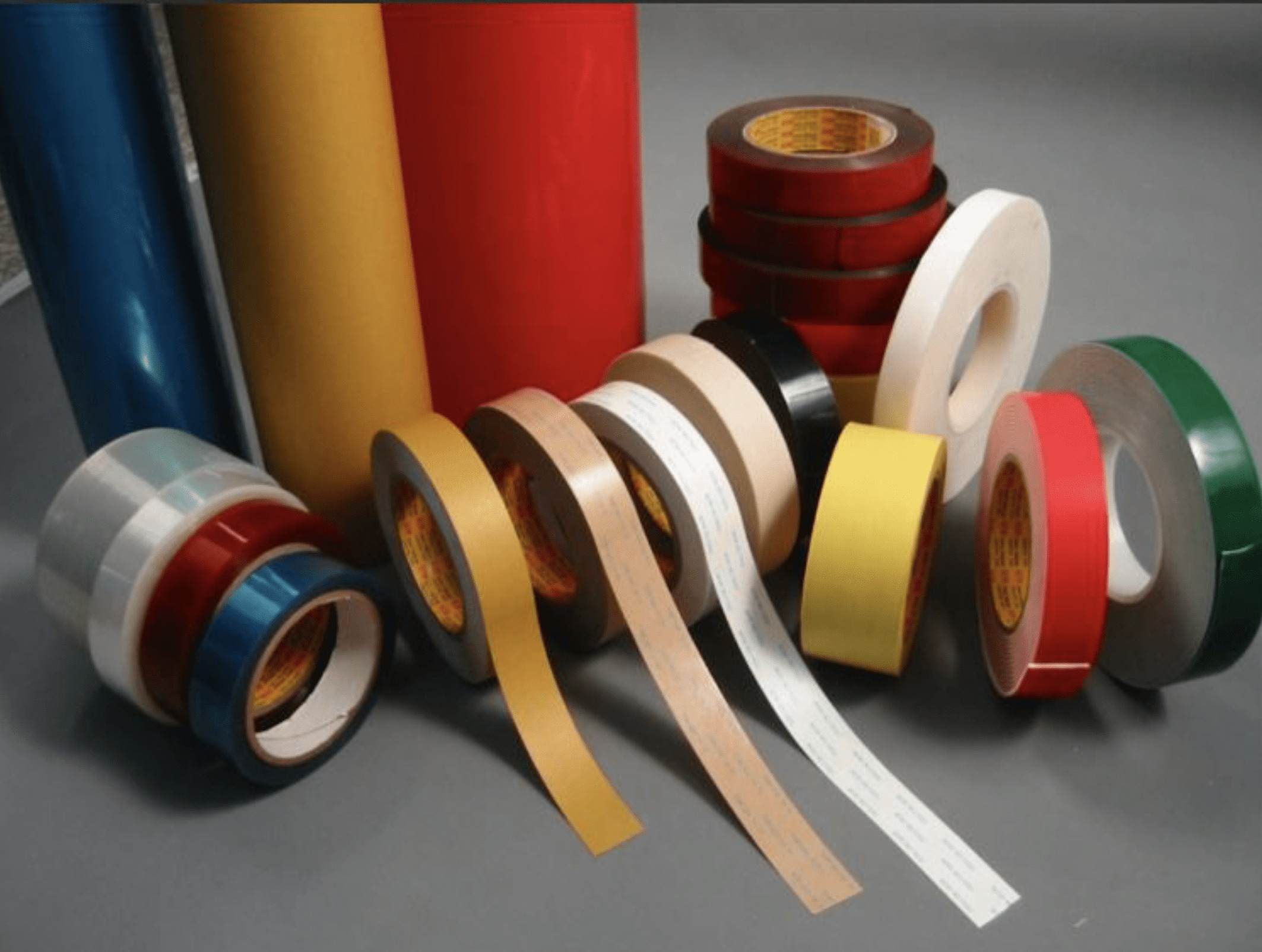
Pressure Sensitive Adhesive (PSA) is a type of adhesive that is activated with pressure. It can be used in various applications such as labels, tapes and graphics. PSAs have a variety of properties that make them suitable for various purposes. PSA is made up of three components: a film or carrier, an adhesive and a release liner. The adhesive layer is usually a rubber-based material such as a thermoplastic elastomer that is activated when pressure is applied.
The adhesive layer provides the bond between the substrate and the adhesive. The release liner is a material that prevents the adhesive from sticking to it when pressure is applied. PSA is typically used for a wide range of applications such as bonding paper, fabric, plastic, metal and other substrates. It is also used in the production of products such as labels, tapes, graphics, and even adhesives. PSA can be used in a variety of temperatures and environments. It can be used in both hot and cold temperatures and can be applied to a wide range of substrates. It is also resistant to water, oil, and chemicals. Overall, PSA is a versatile adhesive that can be used in many different applications. It is a reliable, cost-effective and user-friendly adhesive that has been used for many years. It is the adhesive of choice for many industries due to its wide range of properties and its ability to quickly and easily bond objects together.
What is pressure sensitive adhesive used for?
This type of adhesive is used in a variety of industries, from manufacturing to construction to automotive and beyond. It is often used in the production of labels and stickers, as well as for adhering components to metal, plastic, and other surfaces. It is also commonly used for mounting tapes and adhering a variety of materials such as paper, foam, and fabric. Pressure sensitive adhesive can also be used in medical applications, such as in catheter adhesion or wound dressing. It is also used in a variety of products like tapes, labels, and tapes with adhesive backing.
Pressure sensitive adhesive is known for its strength and versatility, allowing it to be used in many different applications. It is also very easy to apply, requiring only the use of pressure to activate the adhesive. Additionally, because it does not need a solvent or additional heat, it is more cost-effective than other types of adhesives. Overall, pressure sensitive adhesive is a versatile and cost-effective adhesive used in a variety of industries. From labeling products to medical applications, it is a reliable and strong adhesive that is easy to use and apply.
What is an example of a pressure-sensitive adhesive?
It does not require additional heat or solvents in order to work and is often used in place of other adhesives when an extra strong bond is required. An example of a pressure-sensitive adhesive is double-sided tape. This type of adhesive has two layers of adhesive, one on each side of a carrier material. When pressure is applied to the two surfaces, the two layers of adhesive bond together and create a strong bond. Another example of a pressure-sensitive adhesive is contact cement.
This type of adhesive is applied to two surfaces and allowed to dry before they are pressed together. Once they are pressed together, the adhesive bonds the two surfaces together and creates a strong bond. Yet another example of a pressure-sensitive adhesive is hot melt glue. This type of adhesive is applied to one surface and heated until it melts and then it is applied to the other surface. The heat causes the adhesive to bond to the surfaces and create a strong bond. Finally, foam tape is also an example of a pressure-sensitive adhesive. This type of tape uses a layer of foam with an adhesive on one side. When pressure is applied, the adhesive bonds to the surfaces and creates a strong bond.
What is pressure sensitive adhesive backing?
Pressure Sensitive Adhesive (PSA) is a type of adhesive that bonds to surfaces when pressure is applied. It does not require heat or other activation methods to cure, making it a popular choice for many adhesive applications. PSA adhesive backings are specific to this type of adhesive and provide a layer or backing that the adhesive can be applied to. PSA adhesive backings come in a variety of sizes, shapes and materials for different applications. Some backings are made of paper, and others are made of film.
The backing acts as a barrier, allowing the adhesive to be attached to it without sticking to other surfaces. This allows the adhesive to be applied to a specific area and also makes it easier to peel away if needed. The adhesive also comes in different types, such as removable, semi-permanent and permanent. Removable PSA adhesive backings are great for temporary applications where the adhesive can easily be removed when needed. Semi-permanent and permanent PSA adhesive backings are better suited for more permanent applications. PSA adhesive backings are used in a variety of applications, such as mounting materials, attaching objects, and more. They can be used on surfaces such as metal, wood, plastic, glass, fabrics, and many other substrates. PSA adhesive backings are also often used in the automotive, industrial, and medical industries. Overall, PSA adhesive backings are great for a wide range of applications due to their ease of use and versatility. They provide an easy and effective way of bonding materials together without the need for heat or other activation methods.
What is pressure sensitive adhesive used for
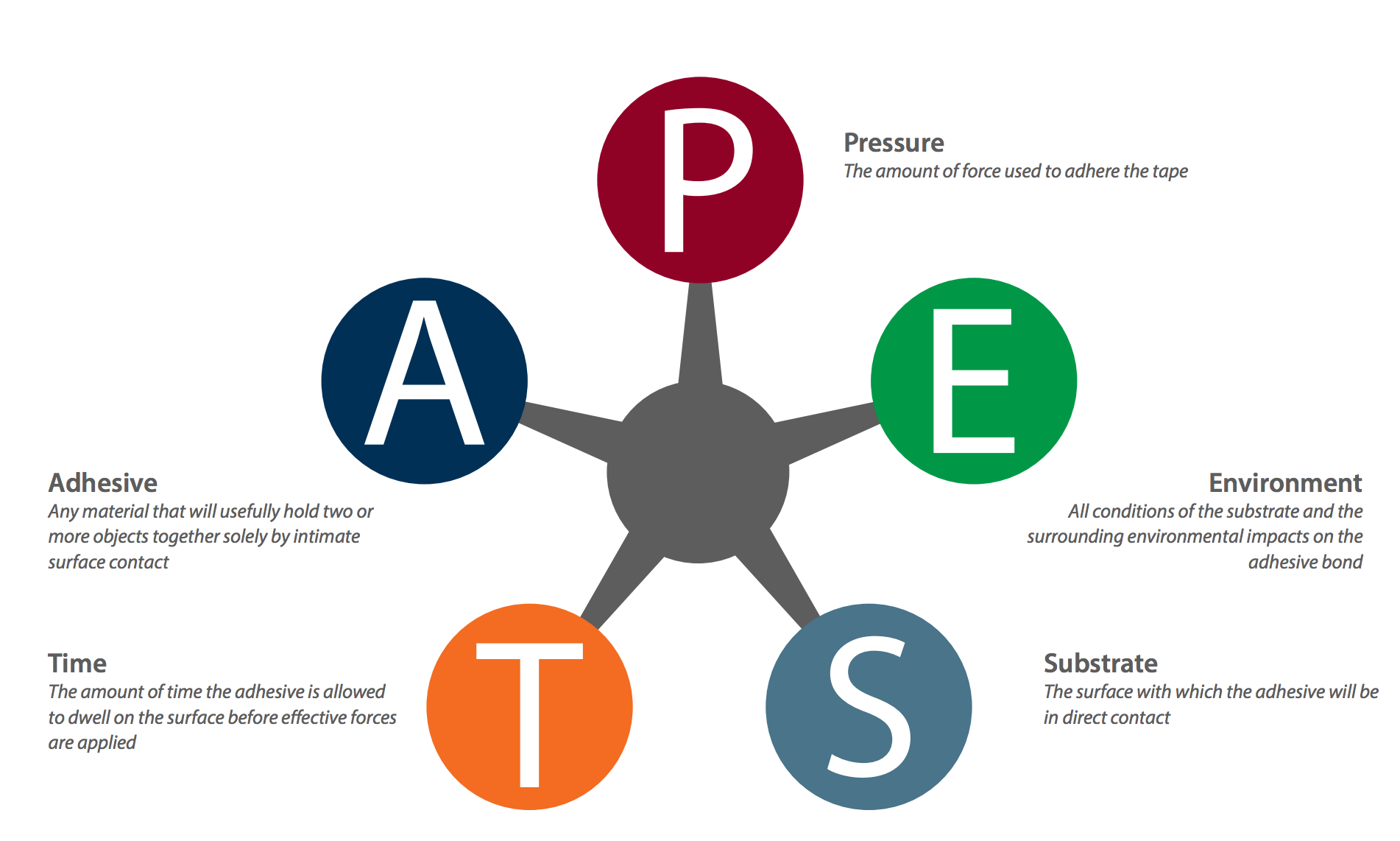
Pressure Sensitive Adhesives, also known as PSA Adhesives, are a type of adhesive that forms an instant bond when pressure is applied. This makes them ideal for use in many applications, including mounting, holding, laminating, fastening, and more. PSA Adhesives are most commonly used in industrial settings and can be found in situations where a quick, permanent bond is required. They are often used in the production of electronics, automotive parts, and signage. PSA Adhesives can also be used to bond labels, tapes, and other materials.
PSA Adhesives are usually applied by rolling, spraying, or other methods. They can also be used in combination with heat and pressure to provide a strong bond. They are also available in a variety of forms, such as foam tapes, films, and liquids. PSA Adhesives are cost-effective and offer many benefits, such as quick application and strong adhesion. They are also highly versatile and can be used in a wide range of temperatures and environments. Additionally, they are often resistant to water and other liquids, making them an ideal choice for use in wet environments. PSA Adhesives are a great choice for many applications due to their quick, strong bond and versatility. They are easy to apply, cost-effective, and can withstand harsh conditions. With these benefits in mind, PSA Adhesives are an excellent choice for a variety of industrial and commercial uses.
How long does Pressure Sensitive Adhesive last?
What is PSA Adhesive? Pressure Sensitive Adhesive (PSA) is a type of adhesive that is applied to a surface and then activated with pressure. It creates a strong bond that can last for many years. PSA adhesives are designed to last for an extended period of time, however, their longevity depends on the type of adhesive and the environmental conditions in which it is used. Generally, a PSA adhesive will last anywhere from a few months to several years, depending on its quality and application. When applying PSA adhesives, it is important to follow the manufacturer’s instructions and use the right product for the job.
Using an adhesive that is not designed for the specific application can decrease the product’s life span. Additionally, exposure to extreme temperatures or humidity can affect the durability of the adhesive. Typically, PSA adhesives are used for indoor applications, such as arts and crafts, signage and labels. For outdoor applications, it is best to use an adhesive specifically designed for outdoor use. These adhesives are designed to last longer in the face of harsh environmental elements. Overall, PSA adhesives are a great choice for many applications. With proper care and maintenance, they can provide strong and lasting bonds for many years.
Is pressure-sensitive adhesive waterproof?
This type of adhesive is often used to bond a variety of materials including paper, plastic, and metal. One of the benefits of pressure-sensitive adhesive is that it is waterproof. This is an important feature as it means that products that use psa adhesive can withstand water, moisture, and other liquids without weakening the bond. This makes it ideal for use in applications where moisture is a factor. This waterproofing property also makes it suitable for use in products exposed to harsh environments.
For example, pressure-sensitive adhesive is regularly used in the automotive industry to bond parts in areas exposed to the elements. The waterproofing feature of psa adhesive is also important in medical and consumer products. For example, it can be used to bond medical devices to the skin, and consumer products such as labels and tape to surfaces that may come into contact with liquids. Overall, pressure-sensitive adhesive is a versatile and reliable adhesive that is waterproof and suitable for use in many applications. Its strong bond and waterproofing capability make it a popular choice for joining different materials.
How long does pressure-sensitive adhesive take to dry?
What is PSA Adhesive? Pressure-sensitive adhesive (PSA) is a type of adhesive that is already pre-applied to a surface, and holds its strength when pressure is applied. It is commonly used in labelmaking, packaging, and other applications. How Long Does PSA Adhesive Take to Dry? The drying time of PSA adhesive depends on the environment and the specific product that is being used. Generally speaking, PSA adhesive will set within 15 minutes to a few hours. However, it is important to note that if the temperature is too cold, the adhesive may not set properly.
How to Speed Up the Drying Time of PSA Adhesive? The drying time of PSA adhesive can be sped up by using a hair dryer or heat gun to heat the surface of the adhesive while it is drying. This will help the adhesive set faster. When Should You Use PSA Adhesive? PSA adhesive is best used in applications where there is not much movement, as it may not hold up to too much movement. It is great for projects where a strong bond is needed, such as making labels, packaging, and for many other applications. How to Ensure a Strong Bond with PSA Adhesive? To ensure a strong bond with PSA adhesive, it is important to make sure that the surface is clean and free of any dirt or debris. This will help the adhesive to stick better. In addition, it is important to make sure the environment is warm enough for the adhesive to fully dry and set.
What is pressure sensitive adhesive made of
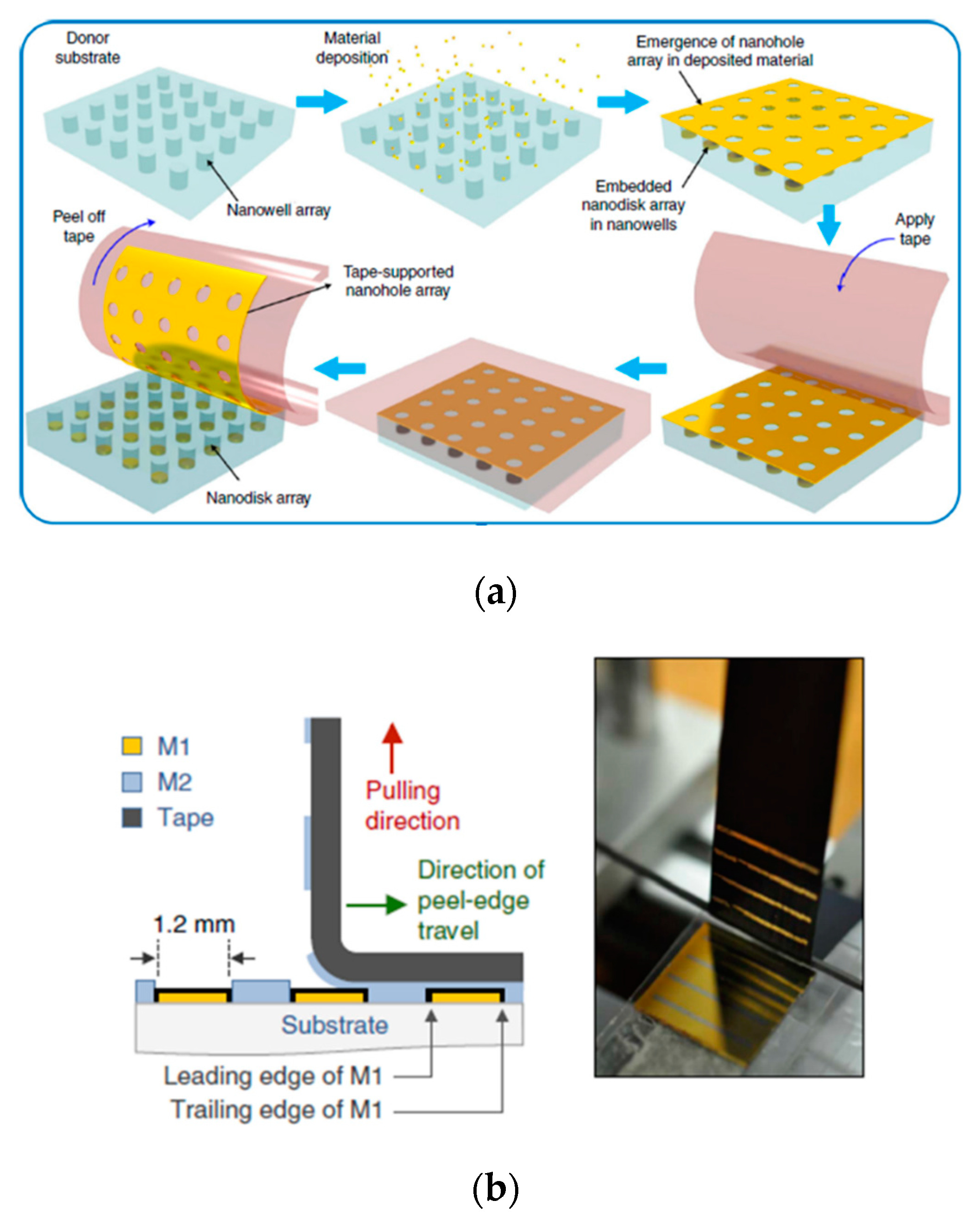
Pressure Sensitive Adhesive (PSA) is a type of adhesive that can be used for many applications. It is made from a combination of rubber, resins, and other materials. The rubber component of the adhesive provides flexibility and helps the adhesive to stick to surfaces. Resins provide strength and durability, so the adhesive can withstand high temperatures and other harsh conditions. The other ingredients can provide additional properties such as water resistance or improved adhesion to specific surfaces.
PSA adhesive can be used for a variety of applications, from attaching labels to surfaces to making seals and gaskets. It can be used in a variety of industries, such as automotive, medical, industrial and construction. PSA adhesive can also be used to affix parts together, such as in the creation of displays, signs and banners. The strength and flexibility of PSA adhesive makes it suitable for many applications. It is also relatively easy to use, as it typically requires no special preparation of the surfaces before application. PSA adhesive is also highly durable and resistant to moisture, making it a good choice for projects where long-term adhesion is needed. Overall, Pressure Sensitive Adhesive (PSA) is a versatile and reliable adhesive used for a variety of applications. It is made from a combination of rubber, resins, and other materials, and is strong and durable enough to withstand various conditions. It is also relatively easy to use, making it a great choice for projects that require reliable adhesion.
What is PSA tape made of?
PSA tape is one of the most popular forms of PSA adhesive. This type of adhesive is usually made from acrylic, rubber, or silicone, and it is designed to be easily removed and reapplied. The adhesive is designed to adhere to any surface and provide a strong bond. In addition to acrylic, rubber, and silicone, PSA tape can also be made from vinyl and other materials. Vinyl is usually used for projects that require a strong bond and resistance to water, while other materials provide a more temporary or removable adhesive.
The adhesive of PSA tape is typically designed to allow for repositioning, easily removal, and residue-free applications. The PSA adhesive can also be used for holding a wide range of materials, including paper, fabric, wood, and metals. Overall, PSA tape is a versatile and strong adhesive that can be used for a variety of applications. It is made from a variety of materials, including acrylic, rubber, silicone, and vinyl, and is designed to provide a strong bond and easy removal.
Is Gorilla tape a polypropylene?
Gorilla Tape is a kind of Pressure Sensitive Adhesive (PSA) tape. It is made up of a strong, weather-resistant backing that is reinforced with a thick layer of rubber-based adhesive. The adhesive used in Gorilla Tape is a polypropylene, making it highly resistant to water, UV rays, and temperatures ranging from -40°F to 200°F. Gorilla Tape is great for a variety of uses, from sealing up cracks and sealing out moisture to providing a strong and reliable bond for a variety of surfaces. It can be used for interior and exterior applications, including automotive, marine, and general-purpose applications.
Gorilla Tape is also an excellent choice for heavy-duty applications. Its thick adhesive layer makes it ideal for sealing cracks and sealing out moisture, and its strong backing helps to ensure a secure bond. It also has a high tensile strength and is highly resistant to tearing and abrasion. Gorilla Tape is also a great choice for use in crafts and home repairs. Its rubber-based adhesive bonds well to a variety of surfaces and its waterproof backing makes it perfect for use in wet or humid environments. It is also great for bonding large items, such as furniture and large pieces of wood. Overall, Gorilla Tape is a great choice for a variety of applications. Its strong and waterproof adhesive makes it ideal for a variety of uses, and its thick backing ensures a secure bond. Its versatility makes it a great choice for both indoor and outdoor applications.
Is pressure sensitive glue water based?
What is PSA Adhesive? PSA Adhesive is a type of pressure sensitive glue that is often used as a bonding agent. It is water based and is designed to adhere to a wide range of surfaces. PSA Adhesive can be used to bond metal, wood, plastic, rubber, and even paper. Pressure sensitive adhesive glue is a type of glue that is activated when pressure is applied. It is usually applied with a roller or a brush and forms a strong bond with the material it is applied to.
The adhesive dries quickly and can be used for a variety of applications. Is pressure sensitive glue water based? Yes, it is. Pressure sensitive adhesive glue is designed to be water based, meaning that it is water soluble and can be easily removed with water. Water based adhesive glue is a great choice for projects that require a strong bond yet can be removed without residue. The advantages of using PSA Adhesive include its flexibility and its ability to bond to a wide range of surfaces. It is also non-toxic and VOC compliant, making it safe for both indoor and outdoor use. PSA Adhesive is also cost-effective and easy to apply. Overall, pressure sensitive glue is a great option for many projects due to its versatility, low cost and ease of use. It is water based, meaning it can be easily removed without leaving any residue. It is also non-toxic and VOC compliant, making it a safe and reliable choice for all your bonding needs.
What is meant by pressure-sensitive adhesive?
Pressure-sensitive adhesive (PSA) is an adhesive that sticks to surfaces when pressure is applied. It does not require any additional heat, solvents, or activation to form a strong bond. PSA adhesives are generally made from a combination of acrylic and rubber-based materials, and they come in a variety of types, including water-based and solvent-based formulas. There are also specialized formulas designed for specific applications, such as medical adhesive or automotive adhesive. PSA adhesives are used in a variety of industries, including automotive, medical, printing, and packaging.
They are used to bond materials together such as metal, glass, plastic, fabric, and paper. The main advantage of PSA adhesives is their ease of use. They are easy to apply and provide a strong bond with minimal effort. Additionally, PSA adhesives can be used in outdoor conditions and are resistant to water, solvents, and high temperatures. PSA adhesives provide a reliable and cost-effective solution for many applications. They are widely used in industry and are a versatile and user-friendly adhesive option.
Is silicone a pressure-sensitive adhesive?
Pressure Sensitive Adhesive (PSA) is a type of adhesive that can be used to bond two materials together. It is commonly used in various industries, and is typically applied in the form of a tape or label. Silicone is a type of polymer material that is often used in industrial adhesives. It has a number of desirable properties, including high heat resistance, low water absorption, and electrical insulation. While silicone can be used as an adhesive, it is not typically classified as a pressure-sensitive adhesive.
A pressure-sensitive adhesive is one that is activated when the adhesive and substrate are subjected to pressure. This type of adhesive typically has a higher level of tackiness and adhesion than regular adhesives. It is also more resistant to shear and impact forces, which is why it is often used on products that need to remain in place under a variety of conditions. PSA adhesives are very versatile, and can be used in a wide range of industries. They are commonly used in medical and automotive applications, as well as for labeling and packaging of products. Some examples include sealing tapes, foam tapes, and transfer tapes. In conclusion, silicone is not a type of pressure-sensitive adhesive. While it can be used as an adhesive, it does not have the same properties as PSA adhesives. For projects that require high levels of adhesion, it is recommended to use a PSA adhesive instead.
What is PSA material?
PSA adhesives, also known as pressure sensitive adhesives, are a type of adhesive which are used in a variety of applications. They are commonly used to bond a wide range of materials, such as paper, metal, and plastic. PSA material is the material which the adhesive is applied to. It is a term used for any type of material which is used in combination with the adhesive. It can be paper, plastic, metal, or another type of material.
When the PSA adhesive is applied to the PSA material, it sticks to it and forms a strong bond. This bond can hold a variety of objects together, such as two pieces of paper or metal. The adhesive can be applied to the PSA material in a number of ways, including spraying, brushing, or rolling. The adhesive is usually applied in a thin layer and allowed to dry before the two materials are pressed together. The amount of pressure used when applying the adhesive to the PSA material will depend on the type of adhesive and material being used. Too much pressure can cause the adhesive to break down over time, while too little pressure may not form a strong enough bond.
Where does PSA come from?
It typically has a sticky, gummy feel, and can be used in a variety of applications. PSA adhesive has its roots in the paper industry. It was first developed in the 1930s and was mainly used for bookbinding and other paper processing uses. Over time, PSA adhesive has become increasingly popular for a range of other uses, from packaging to automotive and electronics manufacturing. Today, PSA adhesive is used in a wide variety of industries, from aerospace and automotive manufacturing to medical and retail applications.
It has become one of the most widely used adhesives in the world, due to its strength, flexibility, and versatility. Due to its versatility, PSA adhesive is often used in combination with other adhesives, such as epoxies, resins, and silicones, for a variety of applications. It can also be used in combination with coatings and heat treatments to increase the strength and reliability of the bond. Developments in PSA adhesive technology have continued to improve its strength, flexibility, and performance. As a result, it is now a highly reliable and trusted adhesive for many industrial and commercial applications.
What chemicals are in tape adhesive?
Pressure sensitive adhesive (PSA) is a type of adhesive that is activated by pressure. It is usually sold in the form of tape, and is commonly used for applications such as labeling and mounting, and to stick things together. PSA adhesive typically consists of a combination of chemicals that are used to create an adhesive bond when exposed to pressure. These chemicals can include acrylics, silicones, epoxies and natural rubber compounds. Acrylics are the most common chemical used in PSA adhesive, as they are flexible and provide good adhesion to a variety of surfaces.
Silicones are also added to PSA adhesive to increase its flexibility and resistance to heat and moisture. Epoxies are often used for their strong adhesion and resistance to a wide range of chemicals, while natural rubber compounds provide a strong bond with good adhesion and flexibility. In addition to these chemicals, PSA adhesive may also contain other additives to improve its performance. These can include fillers, softeners, hardeners, UV stabilizers and corrosion inhibitors. Fillers are added to increase the strength and durability of the adhesive, while softeners and hardeners help improve its flexibility and resistance to temperature changes. UV stabilizers are used to protect the adhesive from the effects of UV rays, and corrosion inhibitors help to prevent the adhesive from degrading due to exposure to moisture and other corrosive agents. All of these chemicals work together to create a strong and durable adhesive that is suitable for a wide range of applications.
What are the ingredients of a adhesive?
What is PSA Adhesive? PSA adhesive is a type of pressure sensitive adhesive, which is a type of glue that bonds materials together under the force of pressure alone. PSA adhesives are typically composed of a combination of ingredients that work together to create a strong bond. The primary ingredients of a PSA adhesive are a tackifier resin, a plasticizer, and a solvent. The tackifier is a sticky, tacky resin that helps the adhesive stick to surfaces. The plasticizer helps to reduce the viscosity of the adhesive, making it easier to apply.
The solvent helps to dissolve the ingredients and make them easier to spread. Other ingredients may be used in combination with the primary ingredients, depending on the purpose for which the adhesive is being used. A filler may be added to strengthen the bond, or a stabilizer may be added to ensure the adhesive retains its properties over time. In addition, some PSA adhesives contain a UV inhibitor, which prevents the adhesive from breaking down when exposed to ultraviolet light. PSA adhesive is a versatile and reliable choice for many types of applications, and is often used in industries such as construction, automotive, and electronic assembly. The different components of a PSA adhesive work together to provide a strong and lasting bond between two surfaces.
What is 3M adhesive made of?
3M adhesive is a type of PSA adhesive that is manufactured by 3M. 3M adhesive is composed of a range of rubber and resin materials, depending on the specific application. Generally, the rubber and resin materials used are acrylic-based, but may also include rubber-based materials such as butyl rubber, SBS rubber, and SIS rubber. The adhesive also contains various plasticizers, curing agents, and other chemicals to enhance the performance of the adhesive. 3M adhesive is designed to provide a strong bond between two surfaces without leaving any residue or damaging the surfaces.
The adhesive is highly waterproof and resistant to chemical and environmental degradation, making it ideal for use in a variety of applications. Additionally, the adhesive is designed to be temperature resistant, allowing it to be used in a variety of temperatures and environments. 3M adhesive is also very economical and easy to use. The adhesive is typically sold in rolls or sheets, allowing it to be cut to the desired shape and size. Additionally, the adhesive can be applied in a range of thicknesses and is available in many different colors. Overall, 3M adhesive is an excellent choice for bonding a variety of surfaces and materials. It is highly durable, waterproof, and resistant to temperature and environmental degradation. Additionally, the adhesive is easy to use and can be applied in different thicknesses and colors.

